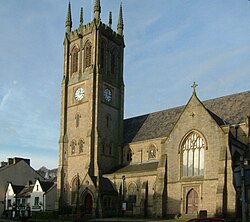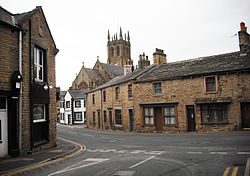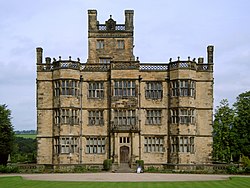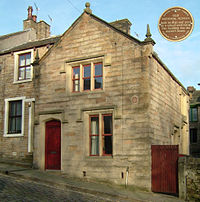Padiham
| Padiham | |
| Lancashire | |
|---|---|
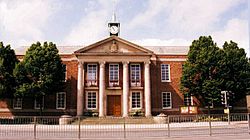 Padiham Town Hall | |
| Location | |
| Grid reference: | SD7933 |
| Location: | 53°47’49"N, 2°18’40"W |
| Data | |
| Population: | 8,998 (2001) |
| Post town: | Burnley |
| Postcode: | BB12 |
| Dialling code: | 01282 |
| Local Government | |
| Council: | Burnley |
| Parliamentary constituency: |
Burnley |
Padiham is a small town on the River Calder in Lancashire, about 3 miles west of Burnley and south of Pendle Hill.
Padiham was originally a rural village lying by the River Calder. It is still surrounded by attractive countryside on an arc running from the north-west to the north-east in the foothills of Pendle Hill.
History
No prehistoric or Roman sites have been found in the urban area and Padiham, a name of Anglo-Saxon origin, is not recorded in the Domesday Book.[1] The first recorded mention of the town, as 'Padyngham', dates from 1294.[2] For hundreds of years it was a market town where produce from Pendleside was bought and sold. The town expanded and was substantially redeveloped during the Industrial Revolution and the central area is now a conservation area.
Padiham's population peaked around 1921 at about 14,000 declining to 10,000 in the early 1960s and 8,998 at the time of the 2001 census.The decline shows people moving out of Lancashire in search of work following the decline of the traditional cotton, coal and engineering manufacturing base during that period.
Industry
In the 19th century, Padiham's industry was based on coal-mining and weaving.
Helm Mill on Factory Lane was the first mill built in 1807. By 1906 there were twenty cotton mills[3] Victoria Mill is the best preserved but now converted into flats; built 1852-53 with an 1873 extension, in Ightenhall Street.[3]
Industrial development was helped by the proximity of the Leeds and Liverpool Canal about 2 miles south. By 1848, Padiham had many coal pits around the town, including two large collieries and a number of smaller workings. The availability of coal and water nearby helped the development of the cotton industry in the town.[1] The arrival of the railway at Hapton in 1840 and Padiham itself in 1877 further boosted industry in the town.[1] The last pit closed around 1870,[4] although mining continued in areas outside the town into the 1950s and open cast mining took place in the 1960s east of the town close to Gawthorpe Hall.
Since the 1960s the remaining cotton mills have also continued a decline which began in the 1930s. Padiham's second role as a manufacturing base has also been in decline since the 1990s. The town's last major employer in this sector, Baxi, closed its factory in March 2007 with the loss of 500 jobs.[5] A modern business park, Shuttleworth Mead,[6] opened in 2001 on the western edge of the town on the site of the old Padiham Power Station[7] which closed in 1993, supported by vast amounts of taxpayers’ money through various channels. In 2007 Fort Vale Engineering moved into the old Mullard/Philips site at Calder Vale Park, Simonstone which had closed in 2004, and developed a brand new purpose-built factory. Fort Vale Engineering Ltd employs around 280 people from around the local area and has brought new business to other local employers.
Parish church
St Leonard's Church, the town's parish church, dates from 1866–69 and is a Grade II listed building.[8] It was built on the site of earlier churches dating back to at least 1451.[9]
The original churchyard did not extend as far to the north as it does today. In 1802 proposals were made to extend the churchyard and remove "nuisances" on the north side of the church. In 1835 the churchyard was extended northwards and it seems likely that at this time the former premises of Padiham Grammar School were purchased and demolished.[1]
Sights about the town
There are five significant halls in the local area: Huntroyde Hall,[10] dating from 1576, and Simonstone Hall, dating from 1660, in nearby Simonstone, are both privately owned.
Gawthorpe Hall was donated to the National Trust in 1970 but is jointly managed with Lancashire County Council which has a 99-year lease. Gawthorpe is in the Ightenhill district.[11] The Trust also runs an office and a tea room in the courtyard of the property.[12][13] Gawthorpe was the family home of the Shuttleworth family who occupied Shuttleworth Hall near Hapton from the 12th century.[14][15] The current building dates from 1639 and is still a working farm. Read Hall and Park is in the nearby village of Read, about a mle west of Padiham on the A671.
Sherry's Lancashire Cotton Mill is a working 19th-century cotton mill which is open to the public.[16]
Padiham Town Hall on Burnley Road, designed by Bradshaw Gass & Hope and built in 1938, is a Grade II listed building.[17]
Padiham Memorial Park at the top of Church Street, was designed by Thomas Mawson, an influential and prolific landscape designer.[18][19][20] It was officially opened in 1921 as a memorial to those from the town who gave their lives in the First World War. It also records those who gave their lives in the Second World War.
The park covers 12 acres on two sites divided by the River Calder. The upper section is mainly formal, dominated by Knight Hill House, currently used as an Age UK day centre, and has a rose garden, lawns and two memorials. The lower section, off Park Street, has two bowling greens, tennis courts, skate park and Padiham's leisure centre. The park is a Green Flag award winner.[21] The park still had the remains of some Second World War air raid shelters in 2008.[22]
Padiham War Memorial itself is at the main entrance to the park in Blackburn Road.[23] There is a second memorial at All Saints' with St John the Baptist off the A671, Padiham Road opposite the George IV pub.[24] A local man, Thomas Clayton, funded the park in his will; public subscription provided additional money for the park’s many features.[25]
Near the war memorial, the Air Crash Memorial[26] is a memorial to several young people from the town killed on 3 July 1970 when a Dan Air de Havilland Comet deviated from its intended course and crashed into high ground at Sierra Del Montseny in north-eastern Spain. The aircraft, destroyed on impact and subsequent ground fire, contained three flight crew, four cabin crew and 105 passengers aboard, all of whom suffered fatal injuries. It was the airline's first fatal accident involving fare-paying passengers.[27]
A number of other buildings in the area, less significant than Gawthorpe and others mentioned above, are still of historic interest. Hargrove can be seen from a public footpath off the Padiham by-pass and is just north of the town and the 1950s council housing estate north of Windermere Road. For over 400 years the house was the home of the Webster family of yeoman farmers.[28] The house today is probably 17th century and part of the Huntroyed estate. Coal from a local outcrop heated the house for many years. Stockbridge House in Victoria Road was occupied by farmers called Holt in 1802 and has a Jacobean chimney.[28] High Whitaker Farm is north-east of Hargrove, also accessible by public footpath from both Higham Road and Grove Lane. The building is 16th century and said to have been used to hide Roman Catholic priests at the time of Henry VIII.[28]
Other houses of note are Priddy Bank Farm and Foulds House Farm, both off Sabden Road, and Arbory Lodge on Arbory Drive.[28]
Outside links
| ("Wikimedia Commons" has material about Padiham) |
References
- ↑ 1.0 1.1 1.2 1.3 Historic Town Assessment Report, Padiham, Lancashire County Council, May 2005, includes several old maps of the town and location of buildings - accessed 18 August 2011
- ↑ About Padiham Accessed 4 February 2010
- ↑ 3.0 3.1 Pevsner, Nikolaus; Hartwell, Clare (revision) (2009). The Buildings of England – Lancashire: North. London and New Haven: Yale University Press. pp. 490–496. ISBN 978-0-300-12667-9.
- ↑ Padiham Life
- ↑ 'Job Threat After Factory Closure' , BBC News website 15 March 2007, accessed 14 January 2008
- ↑ Shuttleworth Mead Business Park. Accessed 5 September 2008
- ↑ Lancashire County Council proposals for public footpath July 2009, Accessed 11 February 2010
- ↑ Lancashire Family History & Heraldry Society. Accessed 13 November 2007
- ↑ Armstrong, Duncan (1985). "Owd Padiham" - a pictorial history. Padiham: Mercer Print.
- ↑ Parks and Gardens UK - based on the English Heritage Register of Parks and Gardens of Special Historic Interest
- ↑ National Trust Website, accessed 2 October 2008
- ↑ Searchable guide to country houses, includes Gawthorpe and other houses owned by the Shuttleworths - accessed 18 April 2010
- ↑ www.genuki.org.uk Accessed 13 November 2007
- ↑ Grimshaw and Shuttleworth family origin website, accessed 15 January 2011
- ↑ Pevsner, Nikolaus; Hartwell, Clare (revision) (2009). The Buildings of England – Lancashire: North. London and New Haven: Yale University Press. p. 321. ISBN 978-0-300-12667-9.
- ↑ Mill shops in Burnley and Padiham 2010 Accessed 21 October 2010
- ↑ Lancashire County Council Library and Information Service Accessed 25 February 2008
- ↑ Burnley Borough Council report on restoration of Padiham Memorial Park. Accessed 28 Jul 2009
- ↑ Parks and Gardens register UK - the park had not been surveyed at the data accessed -3 February 2010
- ↑ Lancashire Gardens Trust, accessed 17 April 2010
- ↑ Green Flag Award Scheme Accessed 27 February 2008
- ↑ "Second World War Air Raid shelters in Memorial Park". http://www.geograph.org.uk/photo/755046. Retrieved 19 January 2009.
- ↑ "First World War Cemeteries, Padiham War memorial (includes WWII)". http://www.ww1cemeteries.com/british_cemeteries_memorials/padiham_wm2.htm. Retrieved 19 January 2009.
- ↑ "World War memorial at All Saints with St John the Baptist, BB12 6PA (includes WWII)". http://www.ww1cemeteries.com/british_cemeteries_memorials/padiham_stjohn_allsaints_wm.htm. Retrieved 19 January 2009.
- ↑ Burnley Borough Council. Accessed 28 February 2008.
- ↑ "Air Crash Memorial, Padiham Memorial Park looking west in the direction of Blackburn". http://www.geograph.org.uk/photo/755068. Retrieved 19 January 2009.
- ↑ "Dan Air, air crash, northern Spain, Friday, 3 July 1970". http://aviation-safety.net/database/record.php?id=19700703-0&lang=en. Retrieved 19 January 2009.
- ↑ 28.0 28.1 28.2 28.3 Nadin, Jack; Armstrong, Duncan (2009). "Padiham in Old Photographs" - contains additional histories of properties mentioned. Stroud, Gloucs, GL5 2QG: The History Press. pp. 10–16. ISBN 978-0-7524-5188-6.
